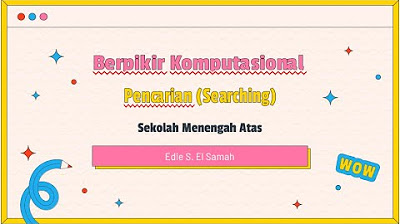Chapter 2 - Computational Thinking | Informatika Booster
Summary
TLDRThis video introduces the concept of computational thinking through relatable real-life examples. The speaker explains the four main concepts: decomposition, abstraction, pattern recognition, and algorithms. By using scenarios such as planning a trip, cooking an omelet, and online shopping, viewers learn how breaking down problems, simplifying tasks, recognizing patterns, and following step-by-step instructions can help solve real-world challenges. The video aims to demonstrate how computational thinking can be applied beyond computer science to enhance everyday problem-solving skills.
Takeaways
- 😀 Computational thinking involves breaking down complex problems into manageable parts, which is known as decomposition.
- 😀 Decomposition helps in identifying the core problems and provides a clear path to find solutions.
- 😀 Planning a trip is a practical example of decomposition, where every aspect of the journey is broken down (e.g., transport, accommodation, activities).
- 😀 Abstraction is the process of simplifying problems by focusing on essential details and ignoring unnecessary complexity.
- 😀 An example of abstraction in cooking is not needing to follow every minor step but just focusing on the key parts of the recipe.
- 😀 Patterns help identify common characteristics between different objects or tasks, such as recognizing trends in e-commerce recommendations.
- 😀 E-commerce apps use patterns to recommend products to users based on previous searches and preferences.
- 😀 Algorithms are step-by-step instructions that guide actions to achieve a desired outcome, similar to following a cooking tutorial.
- 😀 In cooking, algorithms can be seen in following a recipe to ensure consistent results, like making an omelet.
- 😀 The script shows how computational thinking can be applied in everyday tasks, like cooking, and how these principles are connected to problem-solving skills.
Q & A
What is computational thinking?
-Computational thinking is the process of solving problems, designing systems, and understanding human behavior by drawing on concepts fundamental to computer science. It involves breaking down complex problems into smaller parts, identifying patterns, simplifying problems, and creating step-by-step instructions or algorithms.
What does 'decomposition' mean in computational thinking?
-Decomposition is the process of breaking down a complex problem into smaller, more manageable tasks or parts. This allows you to focus on each piece individually, making it easier to find solutions.
Can you give an example of decomposition in everyday life?
-An example of decomposition is when you plan a vacation. Instead of just booking the trip, you break it down into smaller steps: choosing the destination, selecting transportation, booking accommodations, and setting a schedule. Each part is easier to handle this way.
What is the role of 'abstraction' in computational thinking?
-Abstraction involves simplifying a problem by focusing only on the essential details and ignoring unnecessary complexities. This allows you to solve the problem more efficiently by concentrating on the main points.
How does abstraction apply to cooking?
-In cooking, abstraction means you don't need to focus on every tiny detail of a recipe. For example, when making an omelet, you only need to know the main steps: mix the eggs, cook them, and add toppings like cheese, rather than focusing on every minor ingredient or step.
What is pattern recognition in computational thinking?
-Pattern recognition involves identifying similarities or trends that help predict future behavior or outcomes. By spotting recurring patterns, you can make better predictions and decisions.
How is pattern recognition used in online shopping?
-Online shopping apps use pattern recognition to suggest products based on your past searches or purchases. For instance, if you searched for a laptop previously, the app might recommend laptops when you return, because it recognizes that pattern.
What is an algorithm in computational thinking?
-An algorithm is a set of step-by-step instructions that you follow to solve a problem. In the context of cooking, it’s like following a recipe—each step leads to the final result.
How can algorithms be applied to cooking an omelet?
-To cook an omelet, you can follow a specific algorithm: crack the eggs, mix them, add ingredients, heat the pan, pour the mixture, cook until ready, and then serve. Each step is a part of the algorithm, leading to the final dish.
What is the importance of computational thinking in everyday tasks?
-Computational thinking helps break down complex problems into simpler parts, allowing you to solve them more effectively. Whether you're cooking, working, or managing a project, these techniques make tasks more manageable and improve efficiency.
Outlines

Dieser Bereich ist nur für Premium-Benutzer verfügbar. Bitte führen Sie ein Upgrade durch, um auf diesen Abschnitt zuzugreifen.
Upgrade durchführenMindmap

Dieser Bereich ist nur für Premium-Benutzer verfügbar. Bitte führen Sie ein Upgrade durch, um auf diesen Abschnitt zuzugreifen.
Upgrade durchführenKeywords

Dieser Bereich ist nur für Premium-Benutzer verfügbar. Bitte führen Sie ein Upgrade durch, um auf diesen Abschnitt zuzugreifen.
Upgrade durchführenHighlights

Dieser Bereich ist nur für Premium-Benutzer verfügbar. Bitte führen Sie ein Upgrade durch, um auf diesen Abschnitt zuzugreifen.
Upgrade durchführenTranscripts

Dieser Bereich ist nur für Premium-Benutzer verfügbar. Bitte führen Sie ein Upgrade durch, um auf diesen Abschnitt zuzugreifen.
Upgrade durchführenWeitere ähnliche Videos ansehen

Apakah Itu Pola Pikir Komputasi?

Informatika Kelas X Kurikulum Merdeka Bab 2: Berpikir Komputasional | Ngode with Kang Aldi

Pencarian (Searching) - Informatika Kelas X

Kurikulum Merdeka Informatika Kelas 8 Bab 2 Berpikir Komputasional

Contoh Soal Computational Thinking (Berpikir Komputasional) Dengan Pembahasan - Informatika Kelas 7

Yuk, Berpetualang di Dunia Algoritma SMP Kelas 9! | Materi Informatika Elemen Berpikir Komputasional
5.0 / 5 (0 votes)
